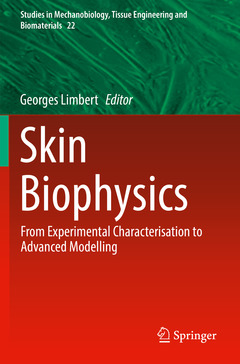Description
Skin Biophysics, 1st ed. 2019
From Experimental Characterisation to Advanced Modelling
Studies in Mechanobiology, Tissue Engineering and Biomaterials Series, Vol. 22
Language: English
Subjects for Skin Biophysics:
Publication date: 10-2020
295 p. · 15.5x23.5 cm · Paperback
Publication date: 06-2019
295 p. · 15.5x23.5 cm · Hardback
Description
/li>Contents
/li>Biography
/li>Comment
/li>
This book presents state-of-the-art experimental and modelling techniques for skin biophysics that are currently used in academic and industrial research. It also identifies current and future challenges, as well as a growing number of opportunities in this exciting research field. The book covers the basics of skin physiology, biology, microstructural and material properties, and progressively introduces the reader to established experimental characterisation protocols and modelling approaches. Advanced topics in modelling theories and numerical implementation are also presented.
The book focusses especially on:
1. Basic physiology, molecular biology, microstructural and material properties of the skin.
2. Experimental characterisation techniques for the skin (including imaging): in vivo and in vitro techniques and combination of those with in silico approaches.
3. State-of-the-art constitutivemodels of the skin: elastic, anelastic and mechanobiological formulations (e.g. growth, ageing, healing).
4. Applications: mechanics, damage, biological growth, healing, ageing and skin tribology.
This book is addressed to postgraduate students in biomedical/mechanical/civil engineering, (bio)physics and applied mathematics, postdoctoral researchers, as well as scientists and engineers working in academia and industry engaged in skin research, particularly, if at the cross-roads of physical experiments, imaging and modelling. The book is also be of interest to clinicians/biologists who wish to learn about the possibilities offered by modern engineering techniques for skin science research and, by so doing, provide them with an incentive to broaden their outlook, engage more widely with the non-clinical research communities and, ultimately, help cross-fertilising new ideas that will lead to better treatment plans and engineering solutions.
Human Skin: Composition, Structure and Visualisation Methods.- Constitutive Modelling of Skin Mechanics.- Constitutive Modelling of Skin Growth.- Constitutive Modelling of Wound Healing.- Constitutive Modelling of Skin Ageing - Inverse Methods.- Experimental Characterisation: Rich Deformations.- Multiscale Characterisation of Skin Mechanics Through In Situ Imaging.- Tension Lines of the Skin.- Experimental Tribology of Human Skin.
Dr Georges Limbert is Associate Professor in the Faculty of Engineering and Physical Sciences at the University of Southampton, UK, and Honorary Associate Professor in the Faculty of Health Sciences at the University of Cape Town, South Africa.
His current research focus is on the constitutive modelling of biological soft tissues with special interest on skin biophysics and the non-linear mechanics and tribology of biological structures. This research aims to unravel the interplay between material and structural properties of biological tissues in health, disease and ageing.
Georges has an MSc in Solid Mechanics from the University of Bordeaux, France and a PhD in Computational Biomechanics from the University of Southampton, UK. He is a Chartered Engineer and Fellow of the Institution of Mechanical Engineers, London, UK.




